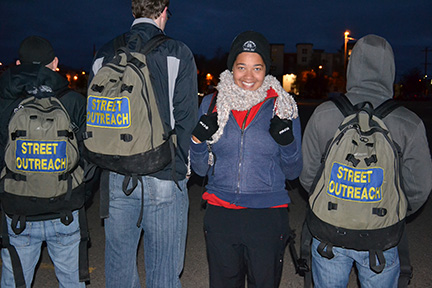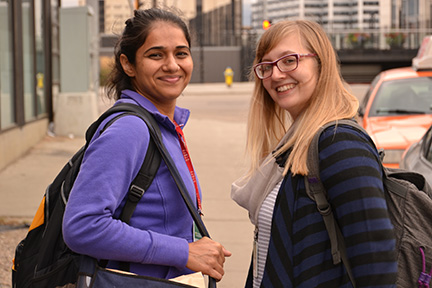
Jessie and Street Outreach
It is just shy of 7 a.m. and the sun has started its ascent into the late summer sky. Jessie arrives at the agreed upon meeting place-an Edmonton parking lot, just north of downtown-and sits patiently while waiting for the others to appear.
Jesse is completing her community clinical rotation at Boyle Street Community Services [BSCS], a social service agency that works with the city's most vulnerable populations, including those who face homelessness, poverty, addiction or marginalization.
Today Jessie is heading out with BSCS's Street Outreach team, comprised of social workers and people with specialization in assertive outreach philosophy, to find clients who may be camped out in Edmonton's North Saskatchewan River Valley. She accompanies the team of six to provide basic assessment and first aid if needed, as well as answer any health related questions clients may have.
Their early morning walk is not a leisurely stroll on a paved path, but a potentially grueling hike into some hard to reach areas, located in the vast network of ravines and natural areas along the urban portion of the North Saskatchewan River. Most people walking by wouldn't suspect that just a few metres away from the walking path is a camp; in fact, the city of Edmonton has dealt with more than 800 homeless camps in this area in the last year.
Jessie is beginning to understand what absolute poverty really looks like, how homelessness leads to numerous health issues and why having a comprehensive understanding of the determinants of health is important in her current and future practice as a nurse.
This is the first time the team has worked closely with a student nurse over an extended time period, and it's been a great experience for all participants.
Aidan Inglis, team lead of Street Outreach at BSCS, notes that the team has been able to learn a great deal from each other. "We are sharing our experiences on the barriers people we work with face on a daily basis, while Jessie has shared learnings from her field with fresh perspective and energy. Jessie's nursing skills have been great for the team to have when we are out working with the community.
Learning, one tuberculosis test at a time
 Vantanna and Anupal are heading over to the George Spady Centre Society, a shelter and detox centre, to collect sputum for tuberculosis [TB] testing from the weekly intake of new detox clients. They are working in partnership with the inner city TB program to help with screening, client assessment and education. Their perception of TB has changed since starting their clinical rotation-they've gone from a basic knowledge and understanding of the disease, to seeing it as a significant threat to public health.
Vantanna and Anupal are heading over to the George Spady Centre Society, a shelter and detox centre, to collect sputum for tuberculosis [TB] testing from the weekly intake of new detox clients. They are working in partnership with the inner city TB program to help with screening, client assessment and education. Their perception of TB has changed since starting their clinical rotation-they've gone from a basic knowledge and understanding of the disease, to seeing it as a significant threat to public health.
While rates of TB are considered low in the developed world, marginalized populations in urban settings are still at risk for being exposed to the disease. Why is this? Crowded shelters facilitate the spread of TB while poor nutrition, substance abuse and HIV infection increases susceptibility. The disease itself also plays a role-it takes up to nine months to cure ordinary pulmonary TB, and treating those who are newly infected before they become infectious is a long and painstaking process. Although access to health care is less of an issue for marginalized populations in Canada, it is still an issue, whether because of a lack of services, or reluctance of marginalized individuals to access care.
Both Vantanna and Anupal are learning the importance of relationship building in nursing and why it is important to look beyond their immediate task of sputum collection and approach the client from a holistic perspective. They know the risk of TB is one of many challenges their clients deal with; they see first-hand the impact of homelessness and the lack of stability that it brings.
Social justice in practice
It's narratives like these that highlight the varied experiences students attain while working with vulnerable populations in Edmonton's inner city. Students learn that homelessness is not a choice and certain populations face a higher degree of challenges based on their race and socioeconomic status. They learn the value of building relationships and approaching clients with empathy and an understanding of the broader context of their lives.
Community health nursing placements help our future nurses comprehend what exactly 'social justice' means in the real world. It goes from being merely a phrase on a page in a textbook something so much more.
At BSCS students sit with clients and listen to stories about their struggles with addictions and homelessness, or hear a mother talk about her determination to provide a stable and loving environment for her children.
For these students, experiencing social justice in a way they never expected has changed the way they see the world and how they will practice as nurses.